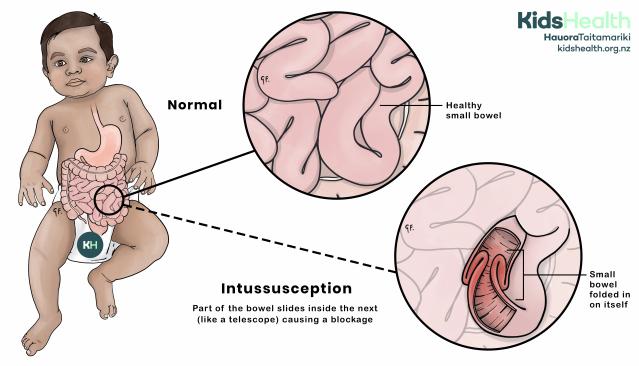Key points about intussusception
- intussusception is a rare condition where one part of the bowel slides inside the next (like a telescope) and causes a blockage
- it is the most common cause of bowel blockage in young tamariki (children)
- the signs of intussusception include tummy pain (your baby may cry and draw their knees up), vomiting and possibly blood in their poo
- intussusception needs urgent treatment in hospital
- rotavirus immunisation is linked with a small increase in the risk of intussusception
What is intussusception?
Intussusception is a rare condition where one part of the bowel slides inside the next (like a telescope) and causes a blockage.

This illustration shows intussusception, where part of the bowel slides inside the next section, like a telescope, causing a blockage.
Source: KidsHealth
transcribeTranscript
The illustration shows a young child with an overlay of the digestive system on their abdomen. A circle highlights the small bowel, with two enlarged diagrams comparing normal and intussusception.
- The top circle is labelled Normal. It shows a healthy small bowel with no blockage. The label reads: Healthy small bowel.
- The bottom circle is labelled Intussusception. It shows part of the small bowel folded in on itself, coloured red to show swelling and blockage. The label reads: Small bowel folded in on itself.
- At the bottom right, text reads: Intussusception – Part of the bowel slides inside the next (like a telescope) causing a blockage.
At the top right is the KidsHealth logo with the website: kidshealth.org.nz
How common is intussusception?
In New Zealand, there are about 65 cases of intussusception for every 100,000 tamariki under one.
Causes of intussusception
In most cases of intussusception, the cause is unknown. Some cases occur after an infection, like a tummy bug.
While the cause of intussusception is unknown, there is a small additional risk of intussusception from receiving rotavirus immunisation (given by mouth), most often in the first week after immunisation.
The increased risk is between 1 and 6 more infants in every 100,000 infants immunised.
The overall benefits of immunisation far outweigh the very small risk of intussusception.
Intussusception is most common in tamariki under 2 years of age but can happen in older tamariki.
Signs and symptoms of intussusception
Signs of intussusception may include:
- severe crying caused by tummy pain - the pain may be colicky and not continuous, but it comes back often
- your baby may draw their knees to their chest while crying
- vomiting, which can become green (caused by bile in the vomit)
- blood in the poo - the poo may have the appearance of 'redcurrant jelly', which is a mix of mucus, cells and blood
- pale skin colour
- being unusually tired or floppy, and not interested in surroundings (lethargic)
When to get medical help for your child
If your baby has some of the symptoms above, and you're worried they might have intussusception, seek urgent medical help. If you can't see a health professional straightaway, call an ambulance. Call 111 within New Zealand (use the appropriate emergency number in other countries).
If your baby has some of the above symptoms and has recently had rotavirus immunisation, tell the health professional.
Managing intussusception
Intussusception is treated in hospital. A radiologist (specialist doctor) can usually unfold the intussusception by using air or fluid to push the folded part of the bowel back into its normal position. In about 30% of cases, an operation is necessary. After surgery, your baby will need to stay in hospital for a few days to recover.
Possible complications of intussusception
Most pēpi (babies) recover completely with no further problems. But, intussusception can happen again in up to 10% of cases.
Acknowledgements
Intussusception illustration by Dr Greta File. Property of KidsHealth.
References
Te Whatu Ora | Health New Zealand. Rotavirus.
Medsafe. NZ. Information for consumers. Information on rotavirus vaccination (Rotarix)
HealthEd. Immunise against rotavirus - protect your child.
Immunisation Advisory Centre. Rotavirus.
